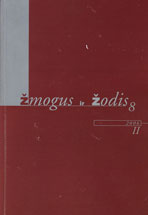Lotyniškosios XVIII amžiaus epigraminės poezijos ypatumai
Peculiarities of the Latin Epigrammatic Poetry of the 18th Century
Author(s): Asta VaškelienėSubject(s): Poetry
Published by: Vytauto Didžiojo Universitetas
Keywords: Baroque; Enlightenment; poetics; rhetorics; literary genres; epigram; epigrammatic poetry
Summary/Abstract: The subject Sf the article is theoretical development of epigram and peculiarities of artistic expression of this genre, characteristic for the poetic compositions ofthe 18th century. The raised problems are dealt with primarily by highlighting the spread of the notion of epigram in the most popular poetics and rhetorics of Europe and the Grand Duchy of Lithuania, written in the 16th-18th centuries. Next, on the basis of publications printed by the Jesuit and Piarist presses, the typical examples ofthe 18th century epigrammatic poetry are discussed. According to the performed survey of the theoretical development of epigram, it would seem that most of the authors of the 16th-18th century poetics adhered to the theory of genres developed by Iulius Caesar Scaliger. Scalliger's statements were relevant to the literary theoreticians like Iacobus Pontanus, Iacobus Masenius, Mathias Casimirus Sarbievius, Iosephus Iuvencius, and Filip Nereusz Golanski. Some theoretical interpretations used to emphasize the poignancy of epigram; others stressed its brevity, yet none of them radically distanced themselves from the basic reąuirements presented by Scaliger. The survey of the 18th century epigrammatic poetry allows us to maintain that in this period essentially no classical epigrams following the pattern of antiquity were composed. As peculiarities of Jesuit and Piarist epigrammatic poetry indicate, the epigrams tended to become simpler, turning into concise panegyric poems. Pronounced satire or poignancy is not typical for them. It is also important to note, that compositions of this genre used to be versifled exclusively in elegiac distich.
Journal: Žmogus ir žodis
- Issue Year: 08/2006
- Issue No: 2
- Page Range: 33-40
- Page Count: 8
- Language: Lithuanian

